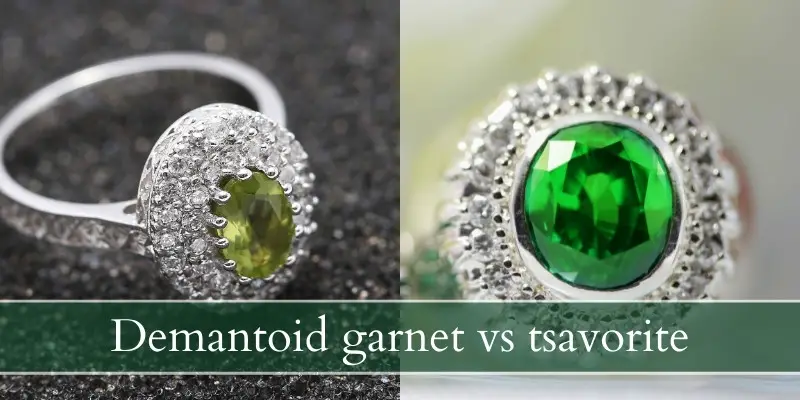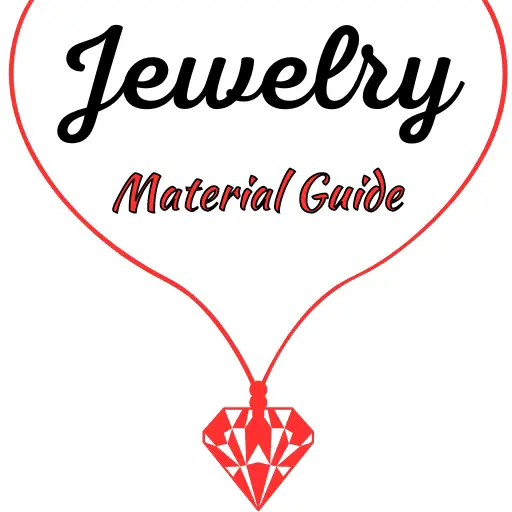If you’re looking at green garnets you’re likely wondering what’s the difference between tsavorites and demantoid garnets. Their names don’t give much away, and they both appear to be green, but why are they called differently ? What are the key differences between tsavorites and demantoid garnets ? Let’s compare the two and see for ourselves.

Demantoid garnet vs tsavorite
Demantoid garnets are golden-green while tsavorites are pure, vibrant green in color. There are usually fine hair-like inclusions in a demantoid garnet that are not present in tsavorites, and there is a steep price difference making demantoid garnets about 4-5 times more expensive than tsavorites.
Tsavorite garnets aren’t as well known as demantoids, but they are far easier to find at a jeweler or retailer because they are much more common, especially in gems up to 2 carats.
What is demantoid garnet ?
Demantoid garnet is a type of andradite garnet, and it owes its green color to chromium (green) and very slight amounts of iron (yellow). It used to be called Uralian or Siberian emerald, after its origin in the mine near Ekaterinburg. For a very long time demantoid garnets were mined exclusively in Russia, from 1868 to 1996 when another significant deposit was found in Namibia.
Russian demantoid garnets have set the standard for what these gems look like, and there is a bit of a difference in color and inclusion when compared to Namibian material. Where Russian demantoid are more green, Namibian demantoids are more yellow and sometimes olive-green, due to more iron. There are also more inclusions in the Russian demantoids than in the Namibian ones.
What is tsavorite ?
Tsavorite is another type of garnet, a type of grossular garnet and it owes its green color to a combination of vanadium and chromium. There isn’t any iron in these gems o turn them slightly yellow.
Tsavorites are newer to the gem world, as they were first found in 1971 and brought to public attention in 1974. They are named after they region they were discovered in, the Tsavo East National Park in Kenya. Now that we’ve introduced the two garnets, let’s compare them.
1. Color – tsavorite has a deep, vibrant green while demantoid garnets are a bit yellow
Color is one of the key differences between demantoid garnets and tsavorite garnets. This is largely due to the presence (or lack thereof) of iron, which in the chemical formula of garnets produces a yellow tint.
Demantoid garnets have a slight yellow hue, even the ones from Russian mines. The Namibian demantoids have a more pronounced yellow hue that can easily turn olive-green and sometimes a bit brown due to the higher iron content.
Tsavorites do not contain any iron in their chemical makeup, so instead the vanadium or chromium is left to manifest the green color with no other undertones.
So if you’re looking for a garnet with a striking green color, vibrant, like sunlight through heavy foliage or perhaps a nearly acid green, a tsavorite is the answer for you. If you’d rather have a warmer shade of green, then demantoids are a better option.
2. Inclusions – demantoid garnet is well known for its horsetail inclusions
Back when demantoid garnets were first discovered, they were from the Russian mines. There is something about that material that makes very fine, thin, golden inclusion prevalent in these garnets. Those inclusions are actually wispy strands of asbestos, but are called horsetail inclusions, since they resemble a horse tail fluttering in the wind. Because of this, and because Russian demantoids were the only ones on the market for a long time, people have come to associated those inclusions with demantoid garnets.
Read also: What Gemstones Are Green ?
Meanwhile, Namibian demantoids show these inclusions far less and much rarer than Russian demantoids. So while the horsetail inclusions are a trademark of demantoids, their lack of presence does not make a garnet not a demantoid.
Tsavorites have some inclusions as well, but when compared to demantoids they appear much less included in general, and when paired with the usually greener color you can use this to figure out which is which.
3. Price – Tsavorite is far more affordable than demantoid garnet
There is a price difference between demantoid garnets and tsavorites. In general demantoids are going to be much more expensive than tsavorites, mostly due to their diamond-like sparkle and then the prestige they’ve garnered over the decades.
Demantoid garnets sell for an average of $3,500 per carat for a medium but vibrant color and noticeable horsetails. Like diamonds, these gems get more and more expensive once they go past the 1 carat mark because they’re rarely found in large rough pieces.
Tsavorites sell for an average of $720 per carat, for a vibrant green with VS clarity. The lighter tones ones, as well as the very dark ones (too shadowy) sell for much less.
So if you’re looking for green garnets that will make up a necklace, or earrings, or something with several gemstones then tsavorites will allow you to work with a smaller budget.
4. Fire and Ri – demantoid garnets are sparklier than tsavorites
The key feature of a demantoid is in tis name, its resemblance to a diamond’s sparkle. This is a combination of the refractive index of 1.88, which is higher than tsavorite’s 1.74, the adamantine luster of demantoid, its higher dispersion, and its general light color that allows fire and brilliance to show through.
Tsavorites simply can’t sparkle as much as a demantoid, no matter what kind of brilliant cut you apply to them. And, because of this, demantoids simply thrive on round brilliant, oval, and cushion cuts.
5. Rarity – tsavorites are easier to come by, and in larger carats
There is a rarity element that you have to keep in mind when discussing tsavorite vs demantoid garnet. Tsavorites are newer on the market, yes, but they are easier to come by as they’re sometimes labeled simply ‘green garnet’. They are easy to find at a jeweler or retailer in almost any carat size you like. They don’t easily reach over 5 carats but they can routinely be found up to 2 carats.
Demantoids are not as common and they tend to be under 1 carat. But, they work well as small gems as they can be paired with some white diamonds for a very beautiful gradient, or a sparkling halo.
6. Prestige – Demantoid garnets have more history than tsavorites
Demantoid garnets are rare, but they’re also better known than tsavorites, especially since these gems were very popular during the Victorian era. In fact, at the time, they were the only green garnet available and any vintage jewelry from that time that claims to have green garnets would (normally) have demantoid garnets.
These gems carry a bit of prestige to them, as they were so very popular with Russian nobility and this bled into European fashion as well.
Tsavorites were introduced to the jewelry stage by Tiffany&Co in the mid ’70s and haven’t had as much time to build up a name for themselves. They’re beautiful in their own way, and more and more people have come to appreciate their nearly-emerald color.
7. Hardness – Tsavorites are more resilient in jewelry that is worn daily
Despite both demantoid garnets and tsavorites being both garnets, there is a bit of a difference in hardness between them. Demantoid garnets, for all their beauty, are a bit on the soft side. They score a 6.5 on the Mohs scale of hardness, while tsavorites score a 7.5 which makes them more scratch-resistant and less likely to chipping.
For this reason, it’s best to use a tsavorite in jewelry that will be worn every single day, such as engagement rings or bracelets, compared to demantoids. We would still recommend you keep all garnets of all types as pendants or earrings, but if you want to use one of these for a ring, a tsavorite is safer.
Is tsavorite or demantoid garnet better as an emerald substitute ?
Tsavorite is a better emerald substitute than demantoid garnet. Tsavorite has the proper color, even without a blue undertone, it has a higher hardness rating, much closer to that of an emerald, and it’s much more affordable. This leaves a lot of your budget available for side stones, filigree detailing, or any other details you may want on your jewelry.

I’m the main author for jewelrymaterialguide.com. I started this site after we did tons of research before our wedding and noticed that there is information about rings, jewelry, and so on that is really hard to find on the internet.






